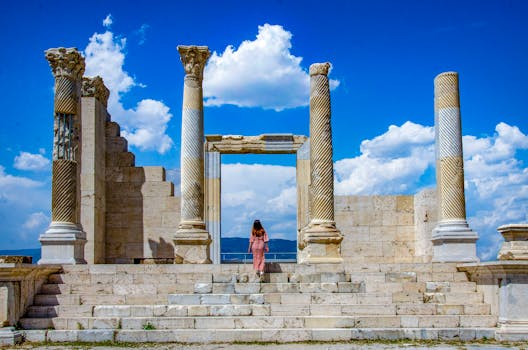Ancient Ruins You’ve Never Heard Of

Ancient ruins have long fascinated historians, travelers, and archaeologists alike. While places like the Colosseum in Rome and the Pyramids of Giza are world-renowned, many equally intriguing ruins remain lesser-known. These hidden gems offer a glimpse into civilizations that shaped our world but have faded into obscurity.
1. Nan Madol, Micronesia
Nan Madol is an ancient city built on a series of artificial islets off the coast of Pohnpei in Micronesia. Often referred to as the "Venice of the Pacific," this site consists of over 90 small islands linked by a network of canals. Dating back to the 8th century, Nan Madol served as the ceremonial and political seat of the Saudeleur dynasty. The ruins include stone walls, platforms, and tombs constructed using massive basalt blocks, some weighing up to 50 tons.
Despite its grandeur, Nan Madol remains shrouded in mystery. The exact methods used to transport and assemble these colossal stones are still debated among scholars. Local legends attribute the city's construction to supernatural forces, adding an element of intrigue to this already fascinating site.
Visiting Nan Madol requires a bit of effort due to its remote location, but those who make the journey are rewarded with a unique experience. The site is relatively untouched by tourism, allowing visitors to explore at their own pace and imagine what life might have been like in this once-thriving city.
2. Derinkuyu Underground City, Turkey
Hidden beneath the surface of Cappadocia lies Derinkuyu, one of the largest and deepest underground cities in the world. This subterranean marvel was likely built around the 8th century BCE by the Phrygians and later expanded by early Christians seeking refuge from Roman persecution. Derinkuyu extends about 60 meters underground and could house up to 20,000 people along with their livestock and supplies.
The city's design is both functional and ingenious, featuring ventilation shafts, wells, kitchens, churches, and even schools. Each level was carefully planned to ensure adequate air circulation and access to water. The inhabitants could block tunnels with large stone doors to protect themselves from invaders.
Today, visitors can explore several levels of Derinkuyu, marveling at the ingenuity of its builders. Walking through its narrow passages and spacious chambers offers a unique perspective on how ancient people adapted to their environment for survival.
3. Ciudad Perdida, Colombia
Deep within Colombia's Sierra Nevada mountains lies Ciudad Perdida, also known as the "Lost City." Discovered in 1972 by treasure hunters, this ancient city is believed to have been founded around 800 CE by the Tairona civilization. Ciudad Perdida predates Machu Picchu by approximately 650 years but remains less known due to its remote location.
The site comprises a series of terraces carved into the mountainside connected by stone pathways and staircases. At its peak, Ciudad Perdida was home to around 4,000 people who lived in circular stone houses with thatched roofs. The city's layout suggests a sophisticated understanding of urban planning and agriculture.
Reaching Ciudad Perdida involves a challenging multi-day trek through dense jungle terrain, but the journey is well worth it. Hikers are greeted with breathtaking views and a sense of awe as they step into this ancient city surrounded by lush greenery.
4. Leptis Magna, Libya
Leptis Magna was one of the most prominent cities of the Roman Empire located on the Mediterranean coast of present-day Libya. Founded by Phoenicians around 1100 BCE and later incorporated into the Roman Empire, Leptis Magna flourished under Emperor Septimius Severus's rule in the early 3rd century CE.
The ruins of Leptis Magna are remarkably well-preserved and showcase Roman architecture's grandeur. Highlights include an impressive amphitheater, a basilica with intricate mosaics, triumphal arches, and extensive bath complexes. The city's harbor remains partially intact, offering insight into its role as a major trade hub.
Political instability has limited tourism in Libya; however, those able to visit will find Leptis Magna an extraordinary window into Roman history outside Italy's borders.
5. Hegra (Madain Salih), Saudi Arabia
Hegra or Madain Salih is an archaeological site located in northwest Saudi Arabia that served as a vital trading center for the Nabataean Kingdom during the first century CE. Often overshadowed by Petra in Jordan (another Nabataean masterpiece), Hegra boasts over 130 rock-cut tombs adorned with intricate carvings reflecting Nabataean artistry blended with Greco-Roman influences.
The site's isolation helped preserve its structures from modern development until recent years when Saudi Arabia began promoting it as part of its cultural heritage tourism initiatives under Vision 2030 program.
Visitors can now explore Hegra's monumental tombs spread across vast desert landscapes while learning about Nabataean culture through guided tours provided by local experts who share insights into daily life during ancient times.
| Ruins | Location | Era | Notable Features |
|---|---|---|---|
| Nan Madol | Pohnpei, Micronesia | 8th century | Artificial islets linked by canals |
| Derinkuyu Underground City | Cappadocia, Turkey | 8th century BCE | Multi-level underground city |
| Ciudad Perdida | Sierra Nevada, Colombia | 800 CE | Terraces carved into mountainside |
| Leptis Magna | Mediterranean coast, Libya | 1100 BCE - 3rd century CE | Roman architecture and mosaics |
| Hegra (Madain Salih) | Northwest Saudi Arabia | 1st century CE | Nabataean rock-cut tombs with carvings |
Ancient ruins interest lies not only in their historical significance but also in their ability to connect us with past civilizations' ingenuity and resilience. Visiting these lesser-known sites provides a unique opportunity to explore human history's hidden chapters while avoiding overcrowded tourist destinations.
If you have a passion for history or simply enjoy discovering new places off-the-beaten-path consider adding these remarkable ruins to your travel bucket list , why not explore some of the more lesser known ones on your next trip!